We’d all like to think that our tap water was fresh, pure, and safe for drinking. But the reality is very different. Public water supplies are laced with a whole host of harmful contaminants, including chromium-6.
In this guide, you’ll learn what chromium-6 is and how it gets into drinking water. I’ll also be sharing the risks associated with chromium-6, and ultimately, how you can remove it from your water supply.
Table of Contents
💡 What is Chromium-6 in Drinking Water?
Chromium 6, known as the “Erin Brockovich chemical”, is a metallic compound in the periodic table that’s classified under chromium. You may also hear chromium-6 referred to as hexavalent chromium.
Unlike some metals, chromium-6 is tasteless and odorless. It occurs in many natural environments, including in ores, rocks, plants, soils, and organic dust. Chromium-6 may even be found in animals and humans.
Though it occurs naturally, chromium-6 is also produced industrially in high quantities. Pollution may occur if manufacturers don’t follow the correct method of waste disposal for this compound.
As well as chromium-6, other identifiable forms of this metal are chromium-3 (or trivalent chromium) and chromium-0 (chromium’s metal form).
Chromium-6 is the most threatening to drinking water quality and safeness, and isn’t an essential human dietary element, so I’ll be focusing on this form of chromium in this article.
Chromium-6 is used in various industrial applications. It’s an essential component for making chrome plates and stainless steel, and can also be used effectively in leather tanning and wood preservation. Additionally, chromium-6 is an ingredient in textile pigments and dyes, conversion coatings, and anti-corrosion overlays.
The EPA has set specific drinking water levels for total chromium*: public drinking water sources should contain less than 0.1 milligrams per liter (mg/l) or 100 parts per billion (ppb) of chromium. As well as adhering to this maximum contaminant level, public water systems are also required to monitor levels of this chemical in their water supplies.
However, a report from the Environmental Working Group (EWG) found that chromium-6 occurs in higher-than-recommended levels in the water consumed by more than two-thirds of people in the US, roughly equating to 200 million Americans.
*Note that the EPA’s guidelines apply to all forms of chromium.
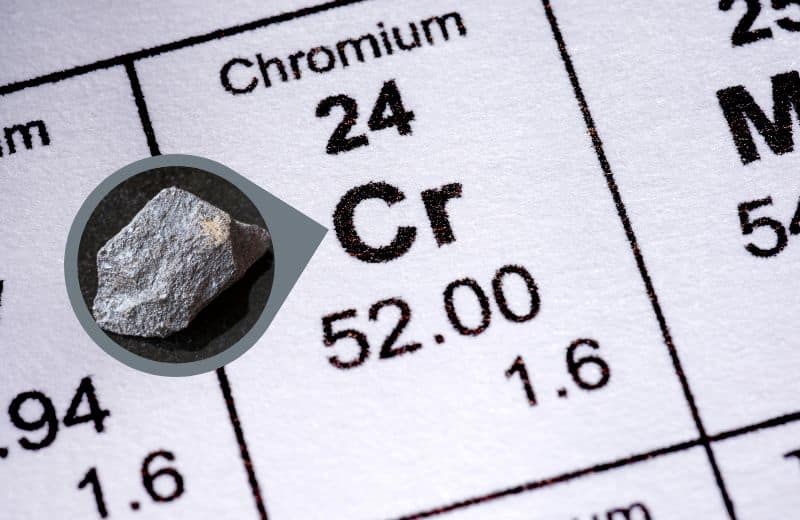
🩺 What Risks Are Associated With Chromium 6?
There are numerous public health risks associated with Chromium-6.
Studies have found that this group of chemical compounds acts as a reproductive toxicant for both males and females. It’s also a carcinogen – a substance that promotes the formation of cancer.
The most known human health effects of chromium-6 are related to inhaling the substance. The group of compounds can also cause allergic dermatitis, or skin reactions. However, more recent findings suggest that ingestion of hexavalent chromium is also capable of causing severe health effects.
In addition to reproductive harm and cancer, chromium-6 can cause asthma flare-ups, anemia, convulsions, liver and kidney damage, ulcers, gastroenteritis, respiratory problems, and eye irritation. These human health effects can be caused by both short- and long-term exposure to chromium-6 in drinking water.
Not all states recognize the dangers of chromium-6, but in 2008, it was added to the Proposition 65 list of toxic contaminants in California.
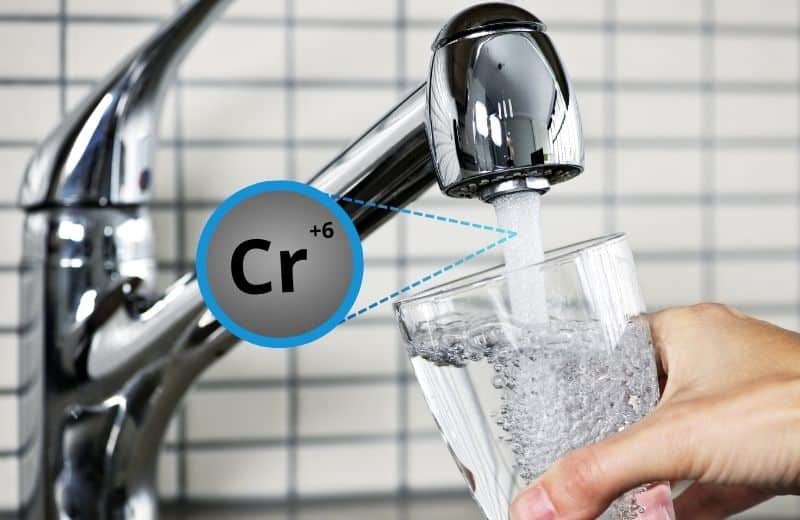
🤔 How Does Hexavalent Chromium Get Into Water?
There are two ways that hexavalent chromium can get into drinking water: naturally and through industrial waste.
Because hexavalent chromium occurs naturally in the ground, including rocks and soil, there’s a high chance that it will come into contact with flowing water, such as rivers and streams.
When rivers pick up this chromium-6, they carry it to reservoirs and water treatment facilities. Though these facilities filter their water to remove specific contaminants, this type of compound is particularly difficult to remove. This is how chromium-6 can end up in unsafe quantities in our drinking water.
Different areas may have different quantities of natural chromium-6 in their soils, depending on geography and other natural factors.
As well as environmental sources, chromium-6 can also enter into drinking water sources through industrial waste. Paint, dyes, chrome plate and stainless steel waste, and wood preservatives can all leach into water from sites storing hazardous waste.
Communities living near to factories that use or dispose of chromium-6 are more likely to have higher levels of this compound in their soils, rocks, and drinking water.

🧪 How to Test for Chromium-6 in Water?
To find out whether your drinking water contains chromium-6, you will need to test your water source.
One option is to use an at-home water test kit for the job. However, I wouldn’t recommend this option for accurately testing for chromium-6. Even if you managed to find a test that indicated the presence of chromium, it’s highly unlikely that it would provide specific results for chromium-6.
The most accurate testing option for chromium-6 is laboratory testing. In this type of testing, you’ll send a sample of your water off to a laboratory, where in-depth tests will be conducted. You’ll typically receive your results within 1-2 weeks.
The advantage of getting a laboratory test is that it’s incredibly thorough, so you’ll know the exact level of chromium-6 you’re dealing with.
You can also purchase test packages if you want to test for other contaminants in your drinking water, or you want to know your total chromium level as well as your chromium-6 contamination.
Lab tests can cost between $40 and $200, depending on local competition, the laboratory you use, and whether you choose to test for additional contaminants alongside chromium-6.

✅ How to Remove Chromium 6 From Water
Unfortunately, it’s highly unlikely that you’ll be successful in appealing for chromium-6 to be removed entirely from your water system before it reaches your home. Removing traces of element chromium is an expensive, tricky task, and not one that many water treatment facilities would be able to consider.
However, you don’t have to drink this type of chromium in your water, as there are several at-home water filtration systems that are capable of removing chromium-6.
Reverse Osmosis
This type of water filter can also remove a broad range of contaminants – up to 99.99% of all total dissolved solids in water, in fact.
A reverse osmosis filtration system works by sending water at a high pressure through a number of filter stages and a reverse osmosis membrane.
The pre-filter and carbon filter in RO systems can remove sediment, chlorine, lead and other aesthetic contaminants. But if you want to remove chromium-6, it’s the reverse osmosis membrane that’s important.
RO membranes have a semi-permeable surface that consists of thousands of tiny pores, usually smaller than 0.0001 microns in size. When water is forced against the membrane, only tiny water particles can pass through, and almost all dissolved substances are left behind in the reject stream.
Chromium-6 is one of the substances that are too large to pass through the RO pores. The filtration system continually flushes while in action, which means that chromium-6, and any other trapped contaminants, are washed down a drain during pure water production.
I recommend looking for reverse osmosis water filters that have been certified to remove chromium-6 from tap water. If an RO water filtration system is certified to NSF/ANSI 58, it means it has been privately tested and deemed to meet requirements for TDS removal, structural integrity and build, contaminant reduction claims, and efficiency rating.
You can buy reverse osmosis filters in a number of styles and sizes:
Countertop Reverse Osmosis Filters
Designed to sit on your kitchen countertop, and require electricity to operate. You’ll need to fill a countertop RO system with water, then wait for RO filtration to take place. Within minutes, you’ll be able to use the dispenser to pour yourself a glass of filtered RO water.
We Recommend: AquaTru
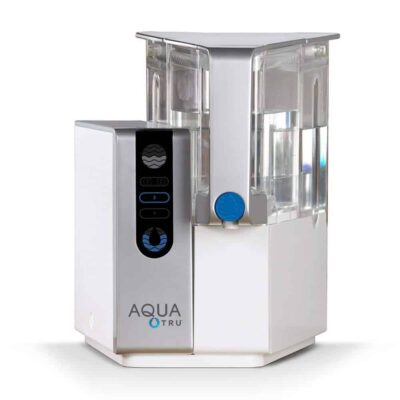
- Tested to remove hexavalent chromium
- Efficiency ratio: 4:1
- Zero installation required
- Simple setup
- 4 stages of filtration
Our readers get 15% off at waterandwellness.com – 👉 Click here for code
Under-Sink Reverse Osmosis Water Filters
These are plumbed into the cold water line underneath your kitchen sink. These filters may be tank-based (meaning they store RO water in a tank, ready for drinking) or tankless (meaning they send water through the system and straight to your faucet).
We Recommend: NU Aqua Efficiency Series Tankless Reverse Osmosis System
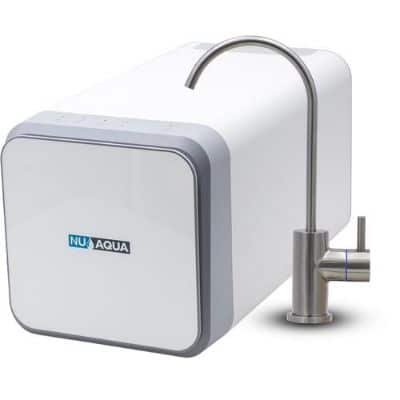
- Tested to remove hexavalent chromium
- Efficiency Ratio: 2:1
- 600 GPD capacity
- Tankless design
- 4 stages of filtration
- Dedicated faucet
- 120 day money back guarantee
My readers get an exclusive 20% off at nuaquasystems.com.com – discount automatically applied when you order through my link.
Whole-Home RO Systems
The most expensive and comprehensive systems on offer today. These systems filter water supplied to your whole home, meaning that your water for drinking and showering, and the water used in your appliances will all be contaminant-free.
We Recommend: US Water Systems Defender Whole House RO System
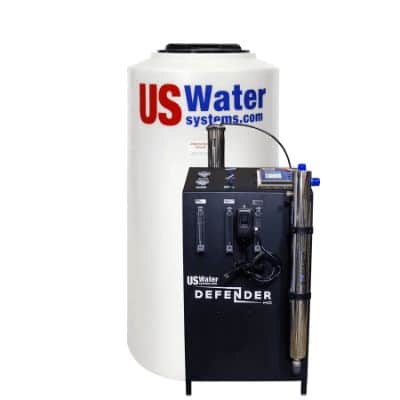
- Efficiency Ratio: 5:1
- 2,000 – 8,000 GPD capacity
- Pressure pump & storage tank included
- Customizable system
- Extremely durable
Specialized Filters
The majority of water filter systems aren’t capable of filtering out chromium-6. Only a specialized system can effectively remove this compound.
When looking for a water filter to remove this type of chromium, look for test results data, independent reviews and FAQs before you make a purchase. It’s also worth looking for a filter that has been NSF tested and certified, so you can be certain that the manufacturer’s contaminant removal claims are accurate.
❔ Frequently Asked Questions
Does reverse osmosis remove chromium 6?
Yes – RO systems are some of the best for reducing this health-concerning contaminant from drinking water. Many RO units on today’s market are NSF/ANSI certified to reduce the chemical by more than 95%.
As a bonus, RO can filter out a broad range of additional health-related contaminants, including chemical substances, toxic heavy metals like lead, dissolved salts, fluoride, and pathogens like bacteria.
Do PUR filters remove chromium-6?
No. At the moment, PUR pitcher filters have not been tested for the reduction of chromium-6, so we can assume that they’re incapable of filtering out this chemical.
Does Brita remove chromium-6?
No. Again, Brita’s pitcher filters can’t currently produce chromium-6-free water. It’s worth checking with the manufacturer periodically to see if this changes in the future, but at the moment, the answer is no.
Does boiling water remove chromium-6?
No. In fact, boiling water would actually increase the PPB (parts per billion) concentration of this metal in your water. This is because some water would evaporate, leaving a smaller quantity of water remaining – containing the same amount of chromium-6.
It’s very difficult to remove any type of contaminant from boiling alone. You would need a distiller system to allow for evaporated, impurity-free water to collect in a clean, separate container.
Does Zero Water remove chromium-6?
Yes. Zero Water is capable of 99.7% removal of the chemical. What makes the Zero Water pitcher any more capable than Brita and PUR? Zero Water uses an ion exchange filter rather than standard carbon filtration.
Does bottled water contain chromium-6?
This depends on the source. However, if you choose to drink bottled water every day for the rest of your life, you’re not guaranteed protection against this metal. Read the label carefully to look for chromium levels. If the label indicates that the water has been purified by RO, there’s a good chance that it’s free from chromium-6.
Does the EPA have a regulation for chromium-6 in drinking water?
No. At the moment, the EPA only has a regulation for total chromium. According to the EPA’s website, it doesn’t seem like there are any plans to revise this regulation as of yet. However, the EPA is currently in the process of assessing the effects of this chemical on human health. After that, we can assume that the EPA will determine whether this type of chromium should have its own regulation, or whether the existing total chromium regulation should be amended based on new information.
How can I find out whether my water contains chromium-6?
Aside from arranging for a laboratory test of your water, you could contact your local treatment facility. The information you’re looking for may be available online, but you could also call or email the facility for a direct response from the source.
Alternatively you can use this interactive map put together by the Environmental Working Group to see if your area is affected.
